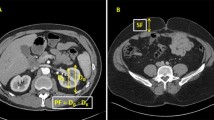Abstract
Purpose
This study aimed to investigate the frequency of fat retention in the bladder using postoperative computed tomography (CT) and the associated imaging or clinical findings in patients who underwent renal tumor surgery.
Methods
We retrospectively reviewed postoperative CT images from 123 patients who underwent surgery for renal tumors (92 patients after partial nephrectomy and 31 after total nephrectomy). Furthermore, we evaluated preoperative tumor characteristics per an established standardized nephrometry scoring system (the R.E.N.A.L Nephrometry Score) for patients with partial nephrectomy. We also investigated whether collecting system repair occurred during surgery.
Results
Fat retention in the bladder was found in 5 patients (5.4%) after partial nephrectomy, but was not observed in any patients after total nephrectomy. No fat retention was seen immediately after partial nephrectomy (4–8 days), but occurred 2–15 months after the surgery. Subsequently, intravesical fat retention disappeared in 3 patients (8, 24, and 16 months later), and it persisted from 19–22 months after surgery in the remaining 2 patients. Collecting system repair occurred in 25 patients (27%) with partial nephrectomy. There was no statistically significant association between fat retention in the bladder and intraoperative collecting system repair (p = 0.12). The association with intravesical fat retention was not significant for either tumor size, distance to the collecting system, or the R.E.N.A.L. Nephrometry Score.
Conclusion
Fat retention in the bladder after partial nephrectomy can be observed using CT, although it is relatively rare. It is clinically asymptomatic and disappears spontaneously in most cases.


Similar content being viewed by others
References
Miller FH, et al. (2007) CT diagnosis of chyluria after partial nephrectomy. Am J Roentgenol 188:W25–W28
Panchal VJ, et al. (2012) Non-tropical chyluria: CT diagnosis. Abdom Imaging 37:494–500
Kim RJ, Joudi FN (2009) Chyluria after partial nephrectomy: case report and review of the literature. ScientificWorldJournal 18:1–4
Komeya M, et al. (2013) Chyluria after partial nephrectomy: a rare but considerable complication. Int J Urol 20:242–245
Soussan M, et al. (2007) Fat-fluid levels in renal caliceal cavities: a CT sign of lipolysis due to urine extravasation after kidney rupture. Am J Roentgenol 189:W163–W165
Martinez-Moya M, et al. (2011) Fat-fluid intravessical level: a new sign of bladder rupture. Am J Roentgenol 197:W373–W374
Schneider J, et al. (2010) Chyluria associated with radiofrequency ablation of renal cell carcinoma. J Comput Assist Tomogr 34:210–212
Kaur H, et al. (2011) Chyluria after radiofrequency ablation of renal tumors. J Vasc Interv Radiol 22:924–927
Ishibashi N, et al. (2010) A case of lipiduria after arterial embolization for renal angiomyolipomas. Cardiovasc Interv Radiol 33:615–618
Kutikov A, Uzzo RG (2009) The R.E.N.A.L. nephrometry score: a comprehensive standardized system for quantitating renal tumor size, location and depth. J Urol 182:844–853
Thickman D (2009) Fat within the wall of the urinary bladder: computed tomographic appearance. J Comput Assist Tomogr 33:695–697
Kanda Y (2013) Investigation of the freely available easy-to-use software ‘EZR’ for medical statistics. Bone Marrow Transpl 48:452–458
Novick AC, et al. (2009) Guideline for management of the clinical stage 1 renal mass. Linthicum: American Urological Association Education and Research
Ljungberg B, et al. (2010) EAU guidelines on renal cell carcinoma: the 2010 update. Eur Urol 58:398–406
Van Poppel H, et al. (2011) A prospective, randomised EORTC intergroup phase 3 study comparing the oncologic outcome of elective nephron-sparing surgery and radical nephrectomy for low-stage renal cell carcinoma. Eur Urol 59:543–552
Stephenson AJ, et al. (2004) Complications of radical and partial nephrectomy in a large contemporary cohort. J Urol 171:130–134
Author information
Authors and Affiliations
Corresponding author
Ethics declarations
Funding
No funding was received for this study
Conflict of interest
The authors declare that they have no conflict of interest.
Ethical approval
All procedures performed in this study were in accordance with the ethical standards of our institutional ethics committee and with the 1964 Helsinki declaration and its later amendments.
Informed consent
For the retrospective nature of this study, written informed consent for individual case was waived under the approval of our institutional review board.
Rights and permissions
About this article
Cite this article
Kazaoka, J., Kusakabe, M., Ottomo, T. et al. CT detection of fat retention in the bladder after partial nephrectomy. Abdom Radiol 42, 1819–1824 (2017). https://doi.org/10.1007/s00261-017-1117-4
Published:
Issue Date:
DOI: https://doi.org/10.1007/s00261-017-1117-4




